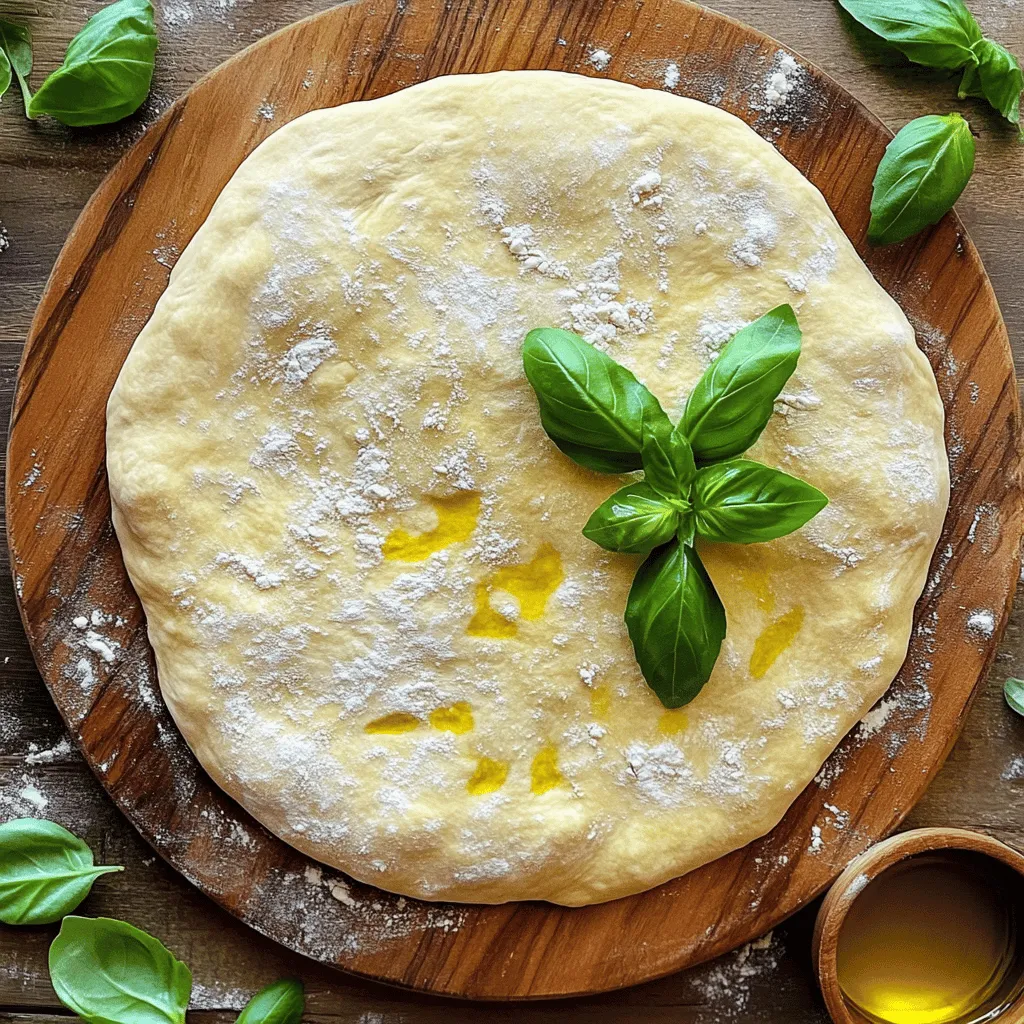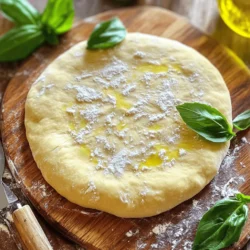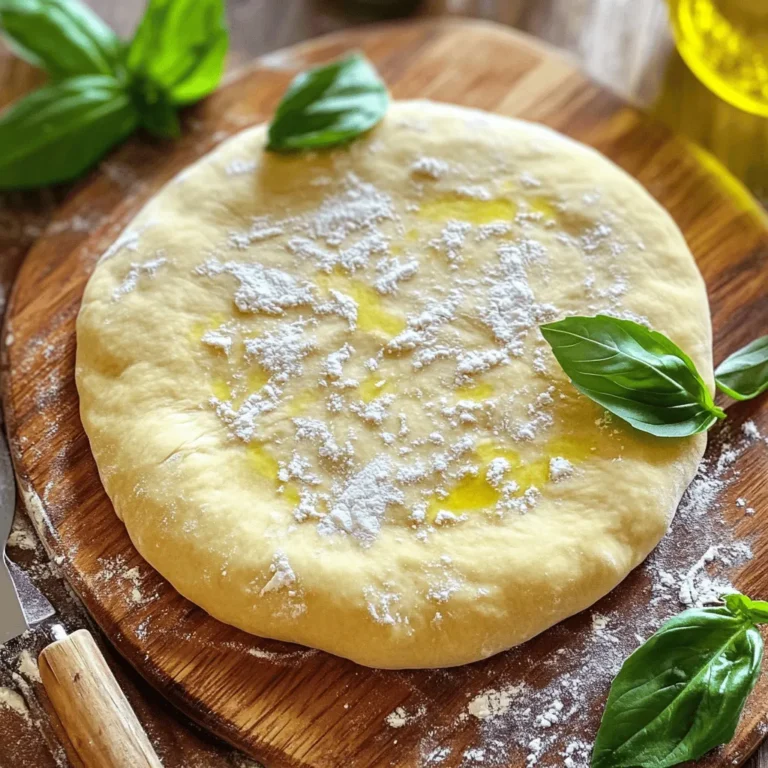If you crave delicious homemade pizza, you need great dough. This simple recipe shows you how to make pizza dough that tastes amazing. With just a few key ingredients and easy steps, you’ll impress your family and friends. Whether you want classic, whole wheat, or gluten-free, I’ve got you covered. Let’s dive into this fun culinary adventure and create something special together!
Ingredients
Essential Ingredients for Homemade Pizza Dough
To make delicious pizza dough, you need some key ingredients. Here’s what you’ll need:
– 4 cups all-purpose flour (plus extra for dusting)
– 1 packet (2 ¼ teaspoons) active dry yeast
– 1 ½ cups warm water (110°F/43°C)
– 2 tablespoons extra virgin olive oil
– 1 tablespoon granulated sugar
– 1 teaspoon sea salt
These ingredients work together to create a dough that is soft and easy to shape. Each one plays a unique role in the dough’s texture and flavor.
Measurements and Substitutes
If you don’t have all-purpose flour, you can use bread flour. It gives your crust a chewier bite. For the yeast, instant yeast works just as well. You can skip the proofing step if you use it. If you prefer a different oil, you can try canola oil or melted butter. They add flavor, too.
Tools Needed for Preparation
Gather these tools for making your pizza dough:
– Large mixing bowl
– Small bowl for proofing yeast
– Wooden spoon or spatula
– Clean surface for kneading
– Rolling pin (optional)
– Plastic wrap or damp cloth for covering
Having these tools ready makes the process smooth and fun. You’ll enjoy making pizza dough from scratch.
Step-by-Step Instructions
Activating the Yeast
To start, we need to wake up the yeast. In a small bowl, mix warm water with granulated sugar. Make sure the water is warm, not hot. Sprinkle the active dry yeast on top and let it sit for 5 to 10 minutes. You will know it’s ready when it gets frothy. This means the yeast is alive and ready to help our dough rise.
Mixing Dry Ingredients
Next, gather a large mixing bowl. Whisk together the all-purpose flour and sea salt. This step is crucial for even flavor. After mixing, create a well in the center of the flour. Pour in the foamy yeast mixture and extra virgin olive oil. This is where the magic starts to happen!
Kneading the Dough
Now it’s time to knead. Use a wooden spoon to mix until a shaggy dough forms. When it’s too tough to stir, transfer the dough to a floured surface. Knead the dough for 8 to 10 minutes. Press, fold, and turn the dough until it feels smooth and elastic. If it sticks too much, add a little extra flour.
Letting the Dough Rise
Shape the kneaded dough into a round ball. Place it in a lightly oiled bowl, turning it to coat. Cover the bowl with a damp cloth. Let the dough rise in a warm spot for about 1 to 1.5 hours. It should double in size. This is when the dough gets fluffy and light.
Shaping the Pizza Dough
Once risen, gently punch the dough down to release air. Turn it out onto a floured surface. Divide it into 2 to 3 equal parts. Each part will make one pizza. Roll out each piece with a rolling pin or stretch it by hand. Shape it as thick or thin as you prefer.
Baking Instructions
Transfer the rolled-out dough to a baking tray or heated pizza stone. Now comes the fun part! Top your dough with sauce, cheese, and your favorite toppings. Bake in a preheated oven at 475°F (245°C) for 12 to 15 minutes. Watch for a golden-brown crust and bubbling cheese. The aroma will fill your kitchen!
Tips & Tricks
Perfecting Dough Consistency
To make great pizza dough, you need the right texture. The dough should be smooth and soft but not sticky. If your dough is too dry, add a little water. If it’s too wet, sprinkle in some extra flour. The goal is to create a dough you can easily handle.
Troubleshooting Common Issues
Sometimes, things may not go as planned. Here are some quick fixes:
– Dough won’t rise: Make sure your yeast is active. Check the water temperature; it should be warm, not hot. If it bubbles after mixing, you’re good to go.
– Dough is too sticky: Add a bit more flour while kneading. Just a little at a time will help.
– Crust is too tough: Knead less. Over-kneading can make the dough tough. Aim for a smooth texture without going too far.
Best Practices for Kneading and Rising
Kneading helps develop gluten. This gives the dough its strength. I recommend kneading for about 8-10 minutes. Use the palm of your hand to push down, fold, and turn the dough.
For rising, find a warm spot. Cover the bowl with a damp cloth. This keeps moisture in. Let it rise until it doubles in size, usually 1 to 1.5 hours.

Variations
Whole Wheat Pizza Dough
You can use whole wheat flour for a healthier pizza. Whole wheat flour has more fiber and nutrients. Simply replace all-purpose flour with whole wheat flour in the recipe. The dough may be a bit denser, but it adds a nice flavor. You might want to add a little more water to keep it soft.
Gluten-Free Pizza Dough Options
If you need a gluten-free option, use a gluten-free flour blend. Many blends work well for pizza. Just make sure it contains xanthan gum, which helps bind the dough.The texture may be different, but the taste will still be delightful.
Flavored Dough Variations
You can add fun flavors to your dough. For example, mix in garlic powder or dried herbs like oregano or basil. This gives your crust an extra kick. Simply add these ingredients when you mix the dry ingredients. You can also brush the dough with garlic-infused olive oil before baking for added flavor.
Storage Info
Storing Unbaked Pizza Dough
Store unbaked pizza dough in the fridge. Wrap it tightly in plastic wrap. This keeps it fresh for up to three days. If you need it longer, consider freezing it instead.
Freezing Instructions for Pizza Dough
To freeze pizza dough, first shape it into a ball. Then, wrap it in plastic wrap. Place the wrapped dough in a zip-top bag. Label the bag with the date. It can stay in the freezer for up to three months. When ready to use, simply thaw in the fridge overnight.
Best Ways to Store Cooked Pizza
Store leftover pizza in the fridge. Place slices in an airtight container or wrap them in foil. This keeps them fresh for about three days. If you want to save them longer, freeze cooked pizza. Wrap each slice tightly in plastic wrap, then put it in a zip-top bag. Cooked pizza can stay frozen for up to two months. Reheat slices in the oven for a crispy crust.
FAQs
How do I know when my dough has risen enough?
You can tell your dough has risen enough when it doubles in size. Press your finger into the dough. If the indent stays, it’s ready. If it springs back, let it rise a bit longer.
Can I use instant yeast instead of active dry yeast?
Yes, you can use instant yeast! It works well and does not need to be activated first. Just mix it with the flour and other dry ingredients. You may need less instant yeast than active dry yeast.
What is the ideal temperature for baking pizza?
The best temperature for baking pizza is around 475°F (245°C). This high heat gives you a crisp crust and bubbly cheese. Make sure to preheat your oven for at least 30 minutes for the best results.
How do I prevent my pizza dough from sticking?
To prevent sticking, use extra flour on your work surface. Dust your rolling pin and hands too. If the dough is still sticky, sprinkle a little more flour as you knead or roll it out.
What toppings go best with homemade pizza?
You can use a wide range of toppings. Classic options include pepperoni, mushrooms, and bell peppers. For a twist, try goat cheese, arugula, or even figs. Mix and match to find your favorites!
What’s the difference between thick and thin crust?
Thick crust has more dough, giving it a chewy texture. Thin crust is crispier and has less dough. The cooking time may vary, with thick crust needing longer to bake. Choose based on your taste!
Ingredients
To make my homemade pizza dough, you need a few simple ingredients. Here’s what you will need:
– 4 cups all-purpose flour (plus extra for dusting)
– 1 packet (2 ¼ teaspoons) active dry yeast
– 1 ½ cups warm water (110°F/43°C)
– 2 tablespoons extra virgin olive oil
– 1 tablespoon granulated sugar
– 1 teaspoon sea salt
These ingredients work together to create a dough that is soft and easy to work with. The flour forms the base, while the yeast helps it rise. Warm water wakes up the yeast, and olive oil adds a nice flavor. Sugar feeds the yeast, and salt brings balance to the dough.
When choosing your flour, all-purpose flour is perfect for this recipe. It gives the dough a good texture. If you want to mix things up, you can use bread flour for a chewier crust.
Now, let’s talk about yeast. Active dry yeast is a great choice. Make sure it is fresh for the best rise. If you see bubbles after mixing it with water and sugar, you are good to go!
I always suggest using warm water. Too hot can kill the yeast, while cold water won’t activate it. Aim for that sweet spot of about 110°F.
This dough can make 2-3 pizzas depending on how thick you like your crust.
You learned the key steps to make homemade pizza dough. We covered important ingredients, tools, and techniques. You can now troubleshoot common issues and explore variations, like gluten-free options. Remember to store your dough properly for later use.
Homemade pizza is fun and rewarding. Enjoy the process and get creative with toppings. Your perfect pizza awaits!


